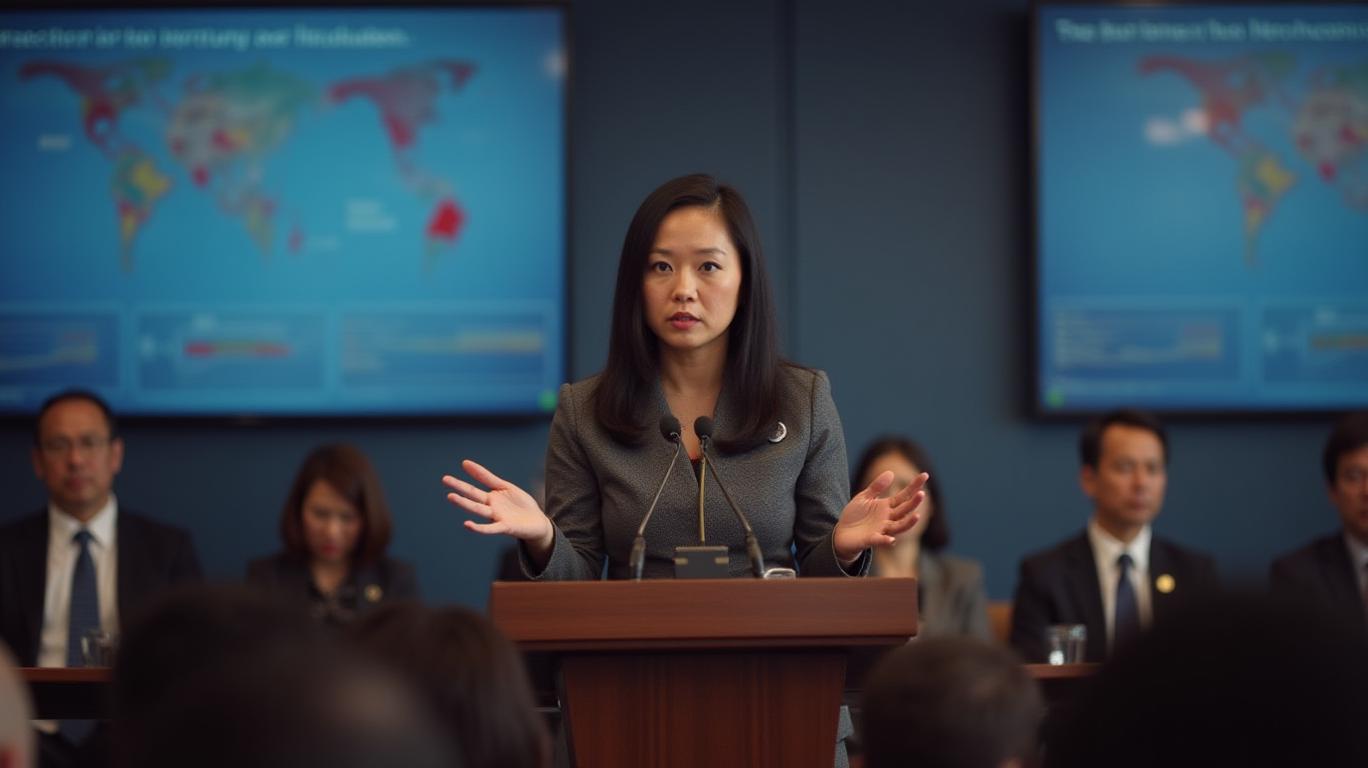U.S. Tariffs Create Market Uncertainty in Wake of Trade Tensions
Epic EventsThursday, May 29, 2025 12:01 am ET
The recent developments regarding U.S. tariffs have injected a notable level of uncertainty into the global market landscape. With President Trump’s administration actively engaging in tariff negotiations, investors are closely monitoring the potential impacts on various sectors, particularly those involving international trade and consumer goods.
Introduction
Tariffs are a crucial component of the U.S. trade policy, serving as both a tool for negotiation and a mechanism for protecting domestic industries. As the current administration seeks to redefine trade relationships, the role of tariffs has become increasingly significant in shaping economic outlooks and investment strategies. The current landscape is characterized by fluctuating tariff rates and ongoing negotiations, contributing to market volatility. The recent announcement to delay the implementation of a 50% tariff on European Union goods until July 9 has provided a temporary reprieve, but the overarching uncertainty remains a key concern for market participants.
Data Overview and Context
Tariffs are taxes imposed on imported goods, aimed at making foreign products more expensive and less competitive compared to domestic goods. The recent trade measures have seen varied rates, with some tariffs reaching as high as 50%. Historical averages of tariffs have typically ranged lower, but the current geopolitical climate has led to an unprecedented escalation. The methodology behind these tariffs involves complex negotiations and strategic decisions, often influenced by broader economic objectives. While the short-term effects may include price adjustments and shifts in supply chains, the long-term implications could redefine international trade dynamics.
Analysis of Underlying Drivers and Implications
The key drivers behind the current tariff landscape include geopolitical tensions, trade imbalances, and efforts to stimulate domestic industries. The U.S. administration's focus on renegotiating trade agreements has led to a series of tariff announcements, with the aim of securing favorable terms for American businesses. These measures have sparked broader economic trends, including shifts in consumer spending patterns and adjustments in global supply chains. As negotiations continue, the possibility of further tariff increases or reductions remains, potentially influencing market stability and economic growth.
Policy Implications for the Federal Reserve
While tariffs are primarily a trade policy tool, their economic impacts could have indirect effects on the Federal Reserve's monetary policy decisions. The Fed may consider the inflationary pressures resulting from higher import prices or the potential slowdown in economic activity due to trade disruptions. As such, the Fed's approach remains cautious, closely monitoring data trends to assess any necessary adjustments in interest rates or other policy measures.
Market Reactions and Investment Implications
The uncertainty surrounding tariffs has led to varied market reactions across different asset classes. Treasury yields may experience fluctuations as investors gauge the impact on economic growth and inflation. Equities, particularly those in sectors directly affected by tariffs, such as manufacturing and consumer goods, may see increased volatility. Currency markets could also respond to shifts in trade balances and investor sentiment. Investment strategies may include focusing on sectors with less exposure to international trade tensions or seeking opportunities in markets where tariff resolutions appear more imminent.
Conclusion & Final Thoughts
In summary, the ongoing tariff negotiations and potential changes in trade policy present significant implications for the global economy and investment landscape. Key drivers include geopolitical strategies and efforts to bolster domestic industries, with potential impacts on inflation and market stability. As the situation evolves, investors should remain vigilant, anticipating further developments that could influence asset valuations and economic forecasts. Upcoming data releases, particularly those related to trade balances and consumer confidence, will be crucial in guiding future investment decisions and policy considerations.
Introduction
Tariffs are a crucial component of the U.S. trade policy, serving as both a tool for negotiation and a mechanism for protecting domestic industries. As the current administration seeks to redefine trade relationships, the role of tariffs has become increasingly significant in shaping economic outlooks and investment strategies. The current landscape is characterized by fluctuating tariff rates and ongoing negotiations, contributing to market volatility. The recent announcement to delay the implementation of a 50% tariff on European Union goods until July 9 has provided a temporary reprieve, but the overarching uncertainty remains a key concern for market participants.
Data Overview and Context
Tariffs are taxes imposed on imported goods, aimed at making foreign products more expensive and less competitive compared to domestic goods. The recent trade measures have seen varied rates, with some tariffs reaching as high as 50%. Historical averages of tariffs have typically ranged lower, but the current geopolitical climate has led to an unprecedented escalation. The methodology behind these tariffs involves complex negotiations and strategic decisions, often influenced by broader economic objectives. While the short-term effects may include price adjustments and shifts in supply chains, the long-term implications could redefine international trade dynamics.
Analysis of Underlying Drivers and Implications
The key drivers behind the current tariff landscape include geopolitical tensions, trade imbalances, and efforts to stimulate domestic industries. The U.S. administration's focus on renegotiating trade agreements has led to a series of tariff announcements, with the aim of securing favorable terms for American businesses. These measures have sparked broader economic trends, including shifts in consumer spending patterns and adjustments in global supply chains. As negotiations continue, the possibility of further tariff increases or reductions remains, potentially influencing market stability and economic growth.
Policy Implications for the Federal Reserve
While tariffs are primarily a trade policy tool, their economic impacts could have indirect effects on the Federal Reserve's monetary policy decisions. The Fed may consider the inflationary pressures resulting from higher import prices or the potential slowdown in economic activity due to trade disruptions. As such, the Fed's approach remains cautious, closely monitoring data trends to assess any necessary adjustments in interest rates or other policy measures.
Market Reactions and Investment Implications
The uncertainty surrounding tariffs has led to varied market reactions across different asset classes. Treasury yields may experience fluctuations as investors gauge the impact on economic growth and inflation. Equities, particularly those in sectors directly affected by tariffs, such as manufacturing and consumer goods, may see increased volatility. Currency markets could also respond to shifts in trade balances and investor sentiment. Investment strategies may include focusing on sectors with less exposure to international trade tensions or seeking opportunities in markets where tariff resolutions appear more imminent.
Conclusion & Final Thoughts
In summary, the ongoing tariff negotiations and potential changes in trade policy present significant implications for the global economy and investment landscape. Key drivers include geopolitical strategies and efforts to bolster domestic industries, with potential impacts on inflation and market stability. As the situation evolves, investors should remain vigilant, anticipating further developments that could influence asset valuations and economic forecasts. Upcoming data releases, particularly those related to trade balances and consumer confidence, will be crucial in guiding future investment decisions and policy considerations.

Disclaimer: The news articles available on this platform are generated in whole or in part by artificial intelligence and may not have been reviewed or fact checked by human editors. While we make reasonable efforts to ensure the quality and accuracy of the content, we make no representations or warranties, express or implied, as to the truthfulness, reliability, completeness, or timeliness of any information provided. It is your sole responsibility to independently verify any facts, statements, or claims prior to acting upon them. Ainvest Fintech Inc expressly disclaims all liability for any loss, damage, or harm arising from the use of or reliance on AI-generated content, including but not limited to direct, indirect, incidental, or consequential damages.

Comments
No comments yet